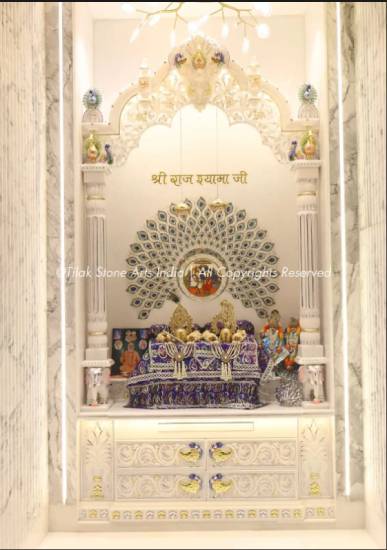The marble temple stands out as a cultural cornerstone in Indian homes, transcending mere religious practice to become a statement of heritage and artistry. Recent years have seen a dramatic shift in how Indians approach sacred spaces within their homes. Gone are the days when simple wooden shrines sufficed. Today’s homeowners seek something more profound – a space that honours tradition while reflecting personal aesthetic values. This has sparked a remarkable revival of handcrafted marble temples, with skilled artisans finding their ancient craft suddenly in high demand once again.
The search for the best marble temple designs has become common among affluent Indians looking to create distinctive spaces for conducting their prayers. This renewed appreciation stems partly from a desire to reconnect with cultural roots in an increasingly homogenised world. Vietnam White Marble has emerged as the preferred material, prized for its luminous quality and fine grain that allows for intricate detailing. What’s particularly striking is how these pieces blend traditional motifs with contemporary sensibilities, creating sanctuaries that feel both timeless and relevant to modern living spaces.
Modern marble temples Mumbai showcase how this traditional craft adapts to metropolitan aesthetics. The city’s wealthy residents commission bespoke pieces that reflect both religious devotion and design sophistication.
Why Are Handcrafted Temples Making a Comeback?
The global Indian diaspora plays a crucial role in this renaissance. Families settled abroad often seek tangible connections to their heritage, and a handcrafted marble temple serves as both a spiritual anchor and a piece of India in their overseas homes. These communities invest significantly in authentic pieces, often working remotely with master craftsmen who create temples specifically designed to fit international homes while maintaining traditional proportions and symbolism.
Social media has amplified this trend, with platforms like Instagram showcasing exquisite marble workmanship to global audiences. The visual nature of these platforms highlights the remarkable difference between mass-produced items and handcrafted pieces. This visibility has created new markets and reconnected artisans with clients who might never have discovered their work through conventional channels.
The Human Touch: Artisanship vs Machine Production
What truly distinguishes handcrafted marble temples is the irreplaceable human element. While machine-cut marble achieves precision, it lacks the subtle variations that give handcrafted work its character. Master artisans approach each stone with reverence, understanding its unique properties and working with them rather than forcing uniformity. This relationship between craftsman and material produces results that machines simply cannot replicate.
The creation process involves numerous skilled hands, from the initial selection of marble blocks to the final polishing. These artisans train for decades, often learning techniques passed down through generations. Their expertise allows them to incorporate minute details that hold deep symbolic meaning – the precise curve of a lotus petal or the exact proportions of a deity figure that adhere to ancient aesthetic principles.
The Cultural Significance Behind the Trend
This renaissance reflects something deeper than aesthetic preference. It represents a cultural reclamation, particularly among younger generations who have grown up in an era of mass production. The deliberate choice to commission handcrafted work signals a rejection of disposable culture and an investment in something meant to last generations, possibly becoming a family heirloom.
The temples themselves function as cultural archives, embodying regional carving styles and motifs that might otherwise fade from memory. Northern Indian temple designs differ markedly from southern traditions, with distinct stylistic elements that reflect local cultural histories. By supporting these diverse traditions, patrons help preserve India’s artistic heritage in living form rather than as museum pieces.
Economic Impact on Traditional Crafts Communities
The surging demand has revitalised entire communities of stone carvers who faced declining prospects just a decade ago. Young artisans who might have abandoned traditional skills for urban jobs now see viable career paths in stone craftsmanship. Training programmes have emerged to ensure these skills continue, with master craftsmen teaching new generations the techniques that cannot be learned from books or videos.
Villages known for particular carving styles have seen economic revivals, with workshops expanding and craftspeople earning sustainable incomes. This economic uplift preserves not just artistic traditions but entire knowledge systems that would otherwise disappear in a single generation. The value chain extends beyond carvers to include suppliers, transporters, and installation specialists who all benefit from this renaissance.
Modern Adaptations of Ancient Traditions
Today’s handcrafted temples often incorporate subtle adaptations for contemporary needs. Space constraints in modern flats mean designs must be more compact without sacrificing religious significance. Lighting elements may be integrated to enhance the visual impact of the carvings, while structural considerations address modern building requirements. These adaptations demonstrate how traditional crafts remain relevant by evolving rather than becoming frozen in time.
Conclusion: The Future of Sacred Craftsmanship
The revival of handcrafted marble temples represents more than a passing trend – it signals a meaningful reconnection with cultural heritage expressed through material choices. As more homes incorporate these artisanal masterpieces, they sustain traditions that might otherwise vanish while creating spaces of beauty and spiritual significance. If you’re considering creating a sacred space in your home, explore the world of handcrafted marble work – not just as a purchase, but as participation in keeping cultural knowledge alive for future generations.







